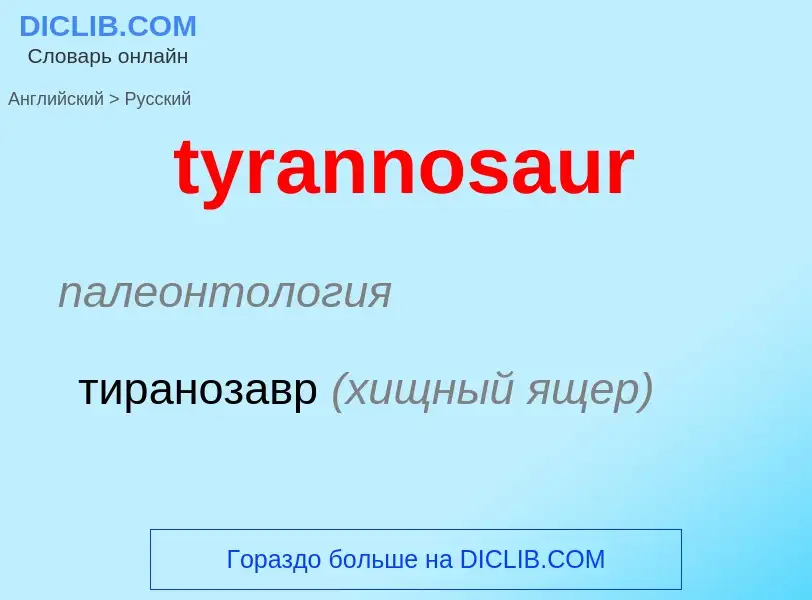Μετάφραση και ανάλυση λέξεων από την τεχνητή νοημοσύνη ChatGPT
Σε αυτήν τη σελίδα μπορείτε να λάβετε μια λεπτομερή ανάλυση μιας λέξης ή μιας φράσης, η οποία δημιουργήθηκε χρησιμοποιώντας το ChatGPT, την καλύτερη τεχνολογία τεχνητής νοημοσύνης μέχρι σήμερα:
- πώς χρησιμοποιείται η λέξη
- συχνότητα χρήσης
- χρησιμοποιείται πιο συχνά στον προφορικό ή γραπτό λόγο
- επιλογές μετάφρασης λέξεων
- παραδείγματα χρήσης (πολλές φράσεις με μετάφραση)
- ετυμολογία
tyrannosaur - translation to ρωσικά
палеонтология
тиранозавр (хищный ящер)
[ti'rænəsɔ:(tirænə'sɔ:rəs)]
существительное
палеонтология
тиранозавр (хищный ящер)
Ορισμός
Βικιπαίδεια

Tyrannosauroidea (meaning 'tyrant lizard forms') is a superfamily (or clade) of coelurosaurian theropod dinosaurs that includes the family Tyrannosauridae as well as more basal relatives. Tyrannosauroids lived on the Laurasian supercontinent beginning in the Jurassic Period. By the end of the Cretaceous Period, tyrannosauroids were the dominant large predators in the Northern Hemisphere, culminating in the gigantic Tyrannosaurus. Fossils of tyrannosauroids have been recovered on what are now the continents of North America, Europe and Asia, with fragmentary remains possibly attributable to tyrannosaurs also known from South America and Australia.
Tyrannosauroids were bipedal carnivores, as were most theropods, and were characterized by numerous skeletal features, especially of the skull and pelvis. Early in their existence, tyrannosauroids were small predators with long, three-fingered forelimbs. Late Cretaceous genera became much larger, including some of the largest land-based predators ever to exist, but most of these later genera had proportionately small forelimbs with only two digits. Primitive feathers have been identified in fossils of two species and may have been present in other tyrannosauroids as well. Prominent bony crests in a variety of shapes and sizes on the skulls of many tyrannosauroids may have served display functions.





![Skull and neck of ''[[Daspletosaurus]]'', from the [[Field Museum of Natural History]] in [[Chicago]]. Skull and neck of ''[[Daspletosaurus]]'', from the [[Field Museum of Natural History]] in [[Chicago]].](https://commons.wikimedia.org/wiki/Special:FilePath/Daspletosaurus FMNH.jpg?width=200)

![The elaborate head crest of ''[[Guanlong]]'', a basal tyrannosauroid from [[China]]. The elaborate head crest of ''[[Guanlong]]'', a basal tyrannosauroid from [[China]].](https://commons.wikimedia.org/wiki/Special:FilePath/Guanlong wucaii head.jpg?width=200)





.png?width=200)
